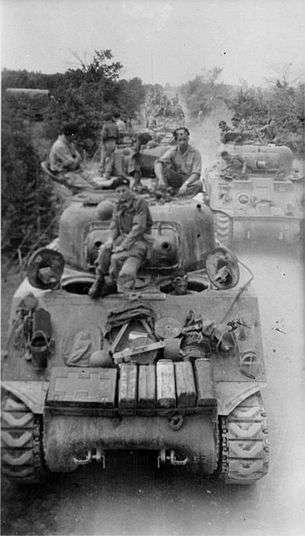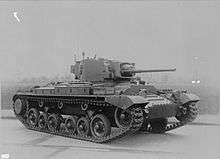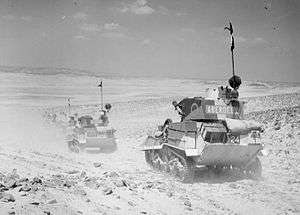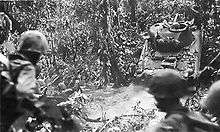Tanks of New Zealand

The New Zealand Army use of tanks from after the First World War, through the interwar period, the Second World War, the Cold War and to the present day has been limited, but there is some history. The New Zealand armed forces developed in the early twentieth century but served alongside the British and other Empire and Commonwealth nations in World War I and World War II.
The outbreak of the Second World War in 1939 led to an expansion of New Zealand's armoured force and the New Zealand Armoured Corps was formed in January 1942.[1] From 1942 small numbers of American light and medium tanks were supplied to and used by the New Zealand Army, along with British tanks. Throughout this period the Army has primarily been a light infantry force, but New Zealand did design its own tanks such as the Schofield tank named after its designer, and the Bob Semple tank designed by New Zealand Minister of Works Bob Semple during World War II.
Overview

Originating out of the need to build military hardware from available materials in New Zealand, the New Zealand designed Bob Semple tank was built from corrugated iron on a tractor base. Built early in the second World War, these tanks were a civilian effort to design and create a means to protect New Zealand.
Designed and built without formal plans or blueprints, it had numerous design flaws and practical difficulties, and was never put into mass production or used in combat.The tanks were constructed without the use of any formal plans or blueprints. Working from an American postcard depicting the conversion of a tractor to a 'tractor-tank', Bob Semple and TG Beck (Christchurch District Works Engineer), improvised the design of the tanks. Using resources available to Bob Semple as Minister of Public Works, the tanks were quickly produced in their Christchurch workshops.

The Vickers Mk VI British Light Tank was initially supplied to the New Zealand forces and used as a scout tank in North Africa, to gather up scattered troops, leaving the main attacks to the heavier tanks. The New Zealand forces also were supplied with the M3 Stuart Tank, an American tank, which was used by the New Zealand Division as a battle tank in North Africa.[2] The New Zealand Division fought in Greece, Crete, the Western Desert and Italy. In the Western Desert Campaign, the division was given the new American M3 Lee/Grant tanks and played a prominent role in the defeat of German and Italian forces in the Second Battle of El Alamein and the British Eighth Army's advance to Tunisia.
In June 1942 twenty-two M3 Hybrid Light Stuart Tanks were the first to arrive in New Zealand,[2] and in October 1941 twenty Valentine Mk II tanks arrived in New Zealand, they were issued to the 1st Army Tank Brigade. More British Valentine tanks arrived and New Zealand received 98 Mk IIs, 80 Mk IIIs and 77 Mk Vs. A total of 18 Mk IIIs were converted with heavier 3 pounder guns. The New Zealand armoured forces also received and operated with the M4 Sherman and Firefly tank in Italy in 1944 with the 2nd New Zealand Division. Later in the war the Valentine infantry tank produced in the United Kingdom with the 2-pounder gun was sent to the Pacific theater and used by the 3rd New Zealand Division.
Design and construction

New Zealand, like its neighbour Australia, had no indigenous armoured fighting vehicle industry, and so it had to allow makeshift tanks such as the Schofield tank. It was expected that armoured fighting vehicles would be provided from the UK. Australia and New Zealand did have some heavy industry that could be turned to the production of armour and armoured vehicles but little had been done. The idea of mechanising the New Zealand Army had been suggested before the war but there hadn't been much progress. The use of the US Disston "Six Ton Tractor Tank" a 1937 vehicle constructed of an armoured box on a Caterpillar Model 35 chassis[3] which had been sold to Afghanistan and China was suggested.[4]
New Zealand had built some improvised armoured trucks and unable to get any tracked carriers from Australia were building their own with armour plate imported from Australia. After the Fall of France in mid-1940, and the loss of most British tanks there, there was no likelihood of production being spared for New Zealand. Rather than obtain the armoured superstructures from the US, it was felt they could produce their own using local materials and resources.
Amoured formations
2nd New Zealand Division
.jpg)
The 4th New Zealand Armoured Brigade came into being on 5 October 1942 after the 4th New Zealand Infantry Brigade was converted into an armoured brigade.[5] They were part of the 2nd New Zealand Division, which had already seen action in the Battle of Greece, the Battle of Crete and in the North African Campaign, having a leading part in the Second Battle of El Alamein.[6]
The brigade arrived in Italy in October 1943 and took part in a number of battles over the course of a sixteen-month campaign in Italy. Upon formation the 4th New Zealand Armoured Brigade was initially composed only of one regiment, the 19th Armoured Regiment. However, by the time it deployed to Italy in October 1943 it was composed of the following units:
- 18th New Zealand Armoured Regiment
- 19th New Zealand Armoured Regiment
- 20th New Zealand Armoured Regiment
- 22nd New Zealand Motor Battalion (October 1943 – November 1944).[7]

The armoured regiments were organized along British lines although with fewer tanks than their British counterparts. A New Zealand armoured regiment consisted of 52 Sherman tanks. These composed a Regimental HQ troop of four tanks and three Squadrons of sixteen tanks.[8] In addition the regiment contained a Recce Troop equipped with Stuart V light tanks in both turreted and turret less configurations and an Intercommunication troop equipped with Lynx light scout cars. Each Squadron consisted of a Squadron Headquarters with four tanks and four troops each of three tanks.[8]

They took part in many battles and together with units of the U.S. 1st Armored Division and Commonwealth troops, formed the New Zealand Corps and were tasked with the capture of the town of Cassino, its skyline dominated by a 13th Century Monastery.[6][8]
Then they took part Spring 1945 offensive in Italy and the New Zealand armoured brigade advanced to the city of Trieste, where they accepted the surrender of the German garrison. Members of Josip Broz Tito’s Yugoslav partisan army had also occupied the city and the presence of the New Zealanders in an area the Yugoslavs considered their spoils of war was not welcome. Tensions remained high, at one point escalating to a face off between 25 Yugoslav T-34s, which had entered the city, and the 19th Armoured Regiment.[8]
3rd New Zealand Division

The 3rd New Zealand Division was a division of the New Zealand Military Forces. Formed in 1942, it saw action against the Japanese in the Pacific Ocean Areas during the Second World War. After completing its initial training in New Zealand the 3rd NZ Division moved to New Caledonia for garrison duty and further training in December 1942 and January 1943. The division saw action in the Solomon Islands campaign during 1943–44 with its tanks being used in Guadalcanal. The 3rd NZ Division moved to Guadalcanal in August 1943 with its Tank Squadron with Valentine Mk V tanks who provided armoured support for 3rd NZ Division.[9][10] From this base, as part of the U.S. I Marine Amphibious Corps (I MAC), the division provided the ground component for three campaigns against small island groups in the Northern Solomons (in all operations the United States Navy provided the naval forces while squadrons from the Royal New Zealand Air Force formed only a small part of the US dominated air forces). While the islands were only lightly held by the Japanese and New Zealand casualties were relatively light, the Kiwi ground troops had to overcome challenging terrain and climatic conditions in these operations. After 1944 it was disbanded and around 4,000 men were sent to Italy to reinforce the 2nd Division.
New Zealand tanks
Bob Semple tank

Due to the limitations of requirements and resources, the Bob Semple tank was a functional failure. By using a large tractor as a base, and bolting on a hastily designed and poorly constructed tank superstructure, the resultant tanks were inadequately armored, extremely heavy (20–25 ton), unstable, restricted by tractor gearing to slow speeds, and had to stop to change gears. Furthermore, due to the shape of the underlying tractor and undue vibrations, shooting from the tank was both difficult and inevitably inaccurate and it never saw action in the field.
Schofield Tank
The Schofield tank was a New Zealand indigenous design built in 1940 when it seemed certain the war might reach New Zealand but did not enter service. It was designed to run on either tracks or wheels.
Vickers Light Tank Mk VI

The New Zealand Division was supplied with the British Mk VI light tank built by Vickers-Armstrongs for the British Army during the interwar period. The Mark VI turret, was expanded in the Mk V to allow a three-man crew to operate the tank, was further expanded to give room in its rear for a wireless set.[11] The weight of the tank was increased to 10,800 pounds (4,900 kg), which although heavier than previous models actually improved its handling characteristics, and an 88 horsepower (66 kW) engine was added to the model to increase its maximum speed to 35 miles per hour (56 km/h).[12] It had the Horstmann coil-spring suspension system which was found to be durable and reliable, although the fact that the tank was short in relation to its width and that it pitched violently on rough ground made accurate gunnery whilst moving exceptionally difficult.[13] The Mk VI possessed a crew of three consisting of a driver, gunner and commander who also doubled as the radio operator, between 4 millimetres (0.16 in) and 14 millimetres (0.55 in) of armour, which could resist rifle and machine gun bullets, and its armament consisted of one water-cooled .303 inch and one .50 inch Vickers machine gun.[13]
M3 Stuart Light Tank

The 4th New Zealand Armoured Brigade which was part of the 2nd New Zealand Division, was equipped initially with Sherman and Stuart tanks and took part in the battle of El Alamein.. The M3 Stuart Light Tank was used by the New Zealand Division in North Africa during World War II and used until the end of the North African campaign. The first 24 Stuart tanks arrived in New Zealand on 22 June 1942, and over 300 Stuart tanks served in New Zealand armed forces.
Valentine Tank

The Valentine tank was used in the war by the 3rd New Zealand Division in the south-west Pacific campaign with the 3 inch howitzer taken from Australian Matilda IV CS tanks. They came equipped with a 2 pounder (37mm) gun and this was changed in a number of them for a 3-inch howitzer which could fire high explosive shells for close support to fight with infantry. 18 tanks of New Zealand’s 255 Valentines were converted and they formed the New Zealand Tank Squadron in 1944.Nine of the converted Mk IIIs C.S. tanks in 1943 and twenty five Mk IIIs saw service in the Solomon Islands with the 3rd NZ Division Special Tank Squadron. The converted CS Valentine tanks were withdrawn in 1956 while the regular Valentine tanks remained in service until 1960, when they were replaced by the M41A1 Walker Bulldog Light Tank.
M4 Sherman Tank

The 4th New Zealand Armoured Brigade was equipped initially with the M4 Sherman, later the New Zealand army received the Firefly tank destroyers which was a Sherman with the turret modified to carry a heavy anti tank gun. The Sherman Firefly tank used by the New Zealand armoured formations AND was based on the US M4 Sherman but fitted with the powerful 3-inch (76.2 mm) calibre British 17-pounder anti-tank gun as its main weapon.
Centurion Tank

The 4th Armoured Brigade was formed during the Second World War in October 1942 from the remnants of the 4th New Zealand Infantry Brigade and was officially disbanded, after the war. But the 4th Armoured Brigade was reformed in April 1953, and gradually the old Valentine tanks were replaced by a few more modern British Centurion main battle tanks with the highly regarded 17 pounder as the main gun, along with the M41 Walker Bulldog tanks.
- New Zealand purchased its first Centurion in 1950, a Mk 3 direct from England. It was intended for training personnel from the RNZAC for service with one of the British regiments in Korea. Named "Scipio Africanus" it was joined by two more Mk 3s in 1953 and these received the names "Scorpion" and "Scarab". In 1963 the Army purchased 8 Centurions from British stocks in Hong Kong, these were a mixture of Mk 5 and 5/1s. Most of these had the Type A barrel though some had the Type B. In addition a Mk I ARV was purchased from England. These were withdrawn from service in 1968 and 8 (including the ARV) were sold to the Australian Army. The ARV served with the Australian Army in Vietnam while the others were used to rebuild Centurions damaged in that conflict. Of those kept in New Zealand two were preserved and two ended up as targets on the ranges at Waiouru.[14]
M41 Walker Bulldog Light Tank

The M41 Walker Bulldog entered service with the New Zealand Army in 1960 which received 10 of the M41s, where it replaced the Stuart and Valentine tanks and was used during the 1970s and early 1980s and was the New Zealand Army’s only tank during this time. The M41 was designed to be air-transportable, and the desired anti-tank capabilities were provided by installing a long 76 mm gun with an advanced rangefinder.
Bishop
The Bishop was a self-propelled vehicle based on the Valentine tank, armed with the 25-pounder gun-howitzer, used in the North African Campaign.
FV101 Scorpion
Though considered a Combat Vehicle Reconnaissance (Tracked) the FV101 Scorpion was fully tracked armed vehicle. Twenty six were acquired in August, 1982 for $8 million. They eventually became obsolete, mostly due to the limited effectiveness of their smaller caliber 76mm gun, and most sold off to other countries via an arms dealer in 2000.[15]
See also
- Schofield tank – New Zealand indigenous tank design
- Sentinel tank – Australian indigenous tank design
- Bob Semple tank – New Zealand indigenous tank design
- History of the tank
- Tanks in World War I
- List of interwar armoured fighting vehicles
- Tanks in World War II
- Comparison of early World War II tanks
- Tank classification
- List of military vehicles
- New Zealand Defence Force
Notes
- ↑ "The Royal New Zealand Armoured Corps – The Royal Tank Regiment Association". royaltankregiment.com. Retrieved 7 November 2016.
- 1 2 "NZ Army Equipment Collection: National Army Museum, Waiouru". armymuseum.co.nz. Retrieved 7 November 2016.
- ↑ Silcox, p. 128
- ↑ Fletcher, p.103
- ↑ "4 New Zealand Armoured Brigade". Ordersofbattle.com. Retrieved 2016-06-29.
- 1 2 "A Brief History of the New Zealand 2nd Infantry Division". Web.archive.org. Archived from the original on 2010-04-28.
- ↑ "Archived copy". Archived from the original on November 20, 2008. Retrieved August 4, 2008.
- 1 2 3 4 "Briefings". Flamesofwar.com. Retrieved 2016-06-29.
- ↑ Lance Whitford (2008-03-12). "History of the 3rd NZ Division Tank Squadron". Kiwisinarmour.hobbyvista.com. Retrieved 2016-06-29.
- ↑ Crawford 2000, p. 149
- ↑ Chamberlain & Ellis, p. 21
- ↑ Tucker, p. 48
- 1 2 Fletcher, p. 7
- ↑ Whitford, Lance. "History of the 3rd NZ Division Tank Squadron". hobbyvista.com. Retrieved 7 November 2016.
- ↑ "Arms dealer signs to buy our cantankerous tanks". 18 September 2000. Retrieved 7 November 2016 – via New Zealand Herald.
References
- Bridges, Jon; Downs, David (2000). No.8 Wire: The Best of Kiwi Ingenuity. Auckland, New Zealand: Hodder Moa Beckett. ISBN 9781869588205.
- Chamberlain, Peter; Ellis, Chris (2001). British and American Tanks of World War Two: The Complete Illustrated History of British, American, and Commonwealth Tanks 1933–1945. London: Cassell & Company. ISBN 0304355291.
- Cooke, Peter (2000). Defending New Zealand: Ramparts on the Sea 1840–1950s. Wellington, New Zealand: Defence of New Zealand Study Group. ISBN 9780473089238.
- Crawford, John (2000). "A Campaign on Two Fronts: Barrowclough in the Pacific". In Crawford, John. Kia Kaha: New Zealand in the Second World War. Auckland: Oxford University Press. pp. 140–162. ISBN 9780195584554.
- Fletcher, David (1989). The Great Tank Scandal: British Armour in the Second World War – Part 1. London: Her Majesty's Stationery Office. ISBN 0-11-290460-2.
- Keith, Haimish (1984). New Zealand Yesterdays: A Look at our Recent Past. Sydney, New South Wales: Reader's Digest Services. ISBN 9780949819833.
- Noonan, Rosslyn J. (1975). By Design: A Brief History of the Public Works Department Ministry of Works 1870–1970. Wellington, New Zealand: New Zealand Government. pp. 172–173. OCLC 2895696.
- Silcox, Harry C. (1994). A Place to Live and Work: The Henry Disston Saw Works and the Tacony Community of Philadelphia. University Park, Pennsylvania: Pennsylvania State University Press. ISBN 9780271010793.
- Tucker, Spencer (2004). Tanks: An Illustrated History of Their Impact. Santa Barbara, California: ABC-CLIO. ISBN 1-57607-995-3.
Further reading
- Phillips, Neville (1957). The Sangro to Cassino. Official history of New Zealand in the Second World War, 1939–45. Italy. Volume 1. War History Branch, Department of Internal Affairs. New Zealand. OCLC 271716539.
- Plowman, Jeffrey; Thomas, Michael (2000). 4th New Zealand Armoured Brigade in Italy. Christchurch, New Zealand: J. Plowman. ISBN 978-0-473-06534-8.
- McLintock, A. H., ed. (1966). "Wars – Second World War: War Against Germany". The Encyclopedia of New Zealand. Wellington, New Zealand: R.E. Owen. OCLC 422330908.
External links
- Pratt, J, fl 1974 :Photograph of tank designed by Robert Semple
- Bob Semple tank or New Zealand's "NI" (Russian)
- English info
- A Bob Semple tank in Christchurch (photo)